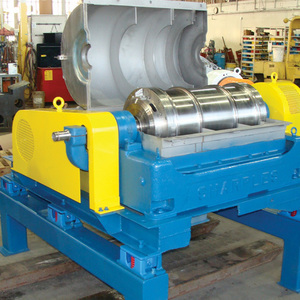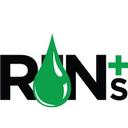Biodiesel Separation, Washing and Polishing: Upstream and Downstream Considerations

PHOTO: KYTE CENTRIFUGE
March 3, 2014
BY Ron Kotrba
Distillation is forgiving of poor pretreatment, reaction and separation, but the added capital and operating costs—not to mention yield losses—can be less than forgiving on a biodiesel plant’s bottom line. Several methods to cleanse and polish biodiesel are utilized, but the story on how well these work begins upstream. “In many cases, it’s a better solution to fix problems at their source rather than to treat the symptoms,” says Warren Barnes, vice president of consulting firm Frazier, Barnes & Associates. “Biodiesel quality prior to any purification step is a critical factor in determining procedure.” Typically the impurities to be removed in purification should be as low as possible upstream of the washing method, whether the plant uses water-washing or dry-washing with silicates or ion exchange resins. Oil-Dri Corp. of America focuses sales of its Select adsorbents on the front side of the biodiesel process, says Bruce Patsey, vice president and general manager of Oil-Dri. “By cleaning up the oil prior to transesterification, metals can be better controlled and the reaction with the catalyst is much more efficient for producing FAME,” Patsey says. “Many biodiesel refineries clean up their oil source with adsorbents prior to transesterification.” After transesterification, separation is essential for the removal of glycerin, salts and soaps. Settling tanks, coalescers or centrifuges are all means to separate. Rod Yawn, president of ALX Enterprises, a manufacturer of DW-R10 dry-wash resins, says approximately 80 percent of biodiesel producers use simple settling tanks, about 15 percent use centrifuges and the remainder use coalescers.
“All a centrifuge does is speed up Mother Nature,” says David Kyte, president of Kyte Centrifuge. “The separation that takes hours for gravity settling in a settling tank or using a coalescer at a G-force of one, a centrifuge can do continuously and instantaneously at a given flow rate by harnessing the power of up to 10,000 Gs and greater. The faster a reactor can be drained and process fluids separated, the faster it can be reused for a new batch.” Kyte says one of his customers coined the phrase “continuous-batch,” and the centrifuge was the critical piece to making the batch process continuous. “The real estate required is also greatly reduced,” he adds, “as centrifuges require a very small footprint relative to settling tanks and coalescers.”
Sediment centrifuges have application in biodiesel production from beginning to end. Both decanter centrifuges and self-cleaning (solid-ejecting) disk stack centrifuges are used to separate suspended, nondissolved solids and water from various feedstocks. After transesterification, they are used to remove glycerin, catalyst salts and soaps. “By separating glycerin prior to methanol recovery, the chance the reaction will reverse itself during the methanol recovery process will be diminished,” Kyte says. “However, it’s very difficult to meet the ASTM limit on free glycerin by centrifuge alone when even a small amount of methanol is present.” Methanol acts as a cosolvent, which keeps some glycerin and soaps in solution with biodiesel. After methanol recovery, additional soap and glycerin will precipitate out of solution with the biodiesel—another opportunity for centrifugal separation. After water-washing, a centrifuge can be used for separation of free, nondissolved water. “When a centrifuge is used prior to additional drying technologies like vacuum dehydrators for separation of both free and dissolved water, the total energy consumption will be greatly reduced when compared to using a stand-alone vacuum dehydration system,” Kyte says. Finally, centrifuges can be used during the glycerin purification process to separate free fatty acids and catalyst salts.
Once the crude biodiesel is separated properly, water-washing or dry-washing occurs next. Barnes says the cost-effectiveness of each method needs to be evaluated based on composition of upstream product. “Water wash and ion exchange are the most common,” Barnes says. Other approaches include use of silicates, such as Dallas Group of America’s Magnesol D-Sol, or products like Schroeder Industries’ trademarked Eco2Pure. “You must evaluate the overall picture since water-washing has significant wastewater treatment cost implications, and the ion exchange cost-effectiveness is dependent on the levels of impurities entering the vessels,” Barnes says. Ryan Santelli, a process and fuel product specialist with Schroeder Industries, says Schroeder does not recommend any type of wet-wash process, “as this adds more variables into the chemical reaction process,” he says. “We feel that the dry-wash process is the simplest, most effective and most economical way to produce biodiesel, regardless of the feedstock being used.”
Eco2Pure is a unique, cellulose-based, natural and sustainable composition of adsorbent technologies, Santelli says, specifically formulated for biodiesel purification from any feedstock. “Eco2Pure is designed to be a filter-free wash process with no consumables in the wash stage,” he says. “Each kilogram of Eco2Pure is capable of purifying between 80 and 190 gallons of biodiesel, making it the lowest cost dry-wash biodiesel purification method in existence today.” Santelli says per-gallon treat costs using Eco2Pure is as low as 1.5 cents. “Eco2Pure outperforms existing ion exchange resin technologies in terms of fuel quality, purification speed as well as price,” he says.
While water-washing requires proper handling and discharge of wastewater, silicates require operation of a filter press and disposal of spent filter cake. “There is also a process loss of approximately 1:1 for silicates use,” Barnes says. “In general, there is greater mass of silicates that would have to be disposed of as opposed to resin. One of the cons to silicates is the flammability of the biodiesel-containing spent cake.” On the other hand, ion exchange resin lasts longer, according to Barnes, “assuming the upstream soap content is not excessive.” In addition, he adds upkeep of a manually cleaned filter press requires more operator effort than resins.
Yawn says dry-wash resins were used to purify 200 million gallons of U.S. biodiesel in 2013, a small percentage of the more than 1.5 billion gallons of biodiesel produced. Kate Mansker, a fuel additives technical manager for MidContinental Chemical Co., which distributes Dow Water & Process Solutions’ Amberlite BD10Dry resins, says silicates are viewed as a workhorse approach to dry-washing, whereas resins perform as the racehorse. “There’s an inherent preference for a simplified technology, which I think the dry wash resins offer, but much of it has to do with what the facility is starting with,” she says. “A lot of facilities are acquisitions, so it’s kind of like an inherited process. Many of the recent calls we’ve gotten are from those who are restarting plants that have been acquired.” Mansker says if an acquired plant had a filter press and used magnesium silicate powders for dry-washing, then that’s what they’re comfortable with. “Not only is it a process change, but it’s an operational mindset change too,” she says about switching from silicates to resins, what she refers to as a “quantum leap.” There are also capital costs to consider in installing resin vessels. “You get some folks who are open to it,” she says, “others have very tight constraints on expenditures and it’s hard for them to justify the changeover, even if it has a short return on investment.” Mansker says treat costs of BD10Dry is about 4 to 5 cents per gallon. Yawn says the advantages resins hold over silicates include cost, safety and manpower. “The use cost for resins ranges from 2 to 5 cents per gallon,” he says. “Use cost for silicates ranges from 10 to 15 cents per gallon.” Yawn says resins are safer to handle than silicates, which carry warnings of worker exposure to silicate dust. “Also, auto-combustion of silicate sludge is also a safety concern,” he says. Finally, Yawn says labor costs for resin dry-wash are significantly lower than silicates. “For silicates, mixing, feeding, operating the filter, and filter-cake handling all require manpower.” He adds, however, that silicates do provide some color removal, a benefit resins do not offer.
Resins are very easy to handle, Mansker says, and they can be pumped out of their vessels in a slurry. “As far as adding them into a vessel,” she says, “it’s a dry resin so there can be static electricity buildup. As a precaution, you can either saturate them or work in a high relative humidity environment at least 60 percent, and then you don’t have that factor in loading your vessel.” She says the BD10Dry has a low bead attrition rate compared to other resins. Yawn says DW-R10 has a 40 percent lower use cost than other resins on the market, and problems with plugging and channeling are much less frequent due to DW-R10’s larger bead size. ALX Enterprises also accepts the return of its spent resins and uses it as part of a product for another industry. “This is an important service in some areas of the country,” he says. Resins can be regenerated with methanol, and Mansker says BD10Dry can be regenerated three to five times before replacement. Yawn says ALX Enterprises has developed new resins for catalyzed esterification of free fatty acids, reduction of total acid number, discharge reduction and/or recycling of wash water, and improved performance of water-washing. “Dry-wash resin is increasingly being used by water-wash plants to polish the fuel,” he says, adding that the resin will remove residual soap, catalyst, glycerol and water.
With current ASTM specifications for cold soak limits, Barnes says filtration at the backend of the process is critical. Patsey says the primary use of diatomaceous earth (DE) in the backend of the biodiesel process is for the removal of sterol glucosides. “Crystals can form in the oil, specifically when producing biodiesel from soybean oil, when the temperature of the oil is reduced,” he says. “Many producers will reduce the temperature of the FAME and let the crystals form in the oil. Once formed, they will run the oil through a DE bed to remove the sterols.” Kyte says while centrifuging can only separate a mixture of nondissolved impurities, DE can be used to separate dissolved contaminants. Santelli says Schroeder customers who use Eco2Pure to dry-wash then use its K9 polishing filter to remove any trace organics. “The last step of this process is to pass the biodiesel through our ColdClear filter assembly to attain the ASTM standard for cold soak,” he says. “Our patent-pending technology combines a unique filtration/adsorption technology that removes crystallization precursors from the biodiesel or biodiesel blend. ColdClear is a simple-to-use filtration system with removable—and disposable—filter elements designed to process on a per-unit volume-treated basis.” The system does not require a chiller. The trademarked ColdClear process is designed to operate between 40 and 100 degrees Fahrenheit. “We have found the product works best at 80 F,” Santelli says. ColdClear is a three-stage system with all filters mounted in series on a single skid. “The first stage serves as a prefilter, and captures solid particulates down to three microns in size,” he says. “The second and third stages utilize custom design elements that combine new adsorption technologies with the proven effectiveness of Schroeder’s high-efficiency Excellement synthetic filtering media.”
Santelli says producers ultimately should be mindful of the total production process. “Adequate filtration at all steps is necessary in order to yield the highest production volumes from a given amount of feedstock,” he says. Barnes, however, says excessive use of filters within the process itself often points to inefficient separations upstream and could lead to unnecessary yield loss.
“Producers should also keep the feedstock consistent,” Santelli says. “When producers change feedstock, the entire production process has to change as well. This will cost large amounts of downtime and creates unusable biodiesel trying to get the chemistry correct. We realize that the feedstock market fluctuates, but any short-term monetary gain realized by changing feedstock is lost due to this fact.”
Author: Ron Kotrba
Editor, Biodiesel Magazine
218-745-8347
rkotrba@bbiinternational.com
Advertisement
Advertisement
Related Stories
Biodiesel capacity in the U.S. and Canada dipped slightly stable in 2024, with several renewable diesel producers reporting headwinds and lower margins alongside a drove of SAF projects in various stages of development.
The IEA’s Task 39 group has new research regarding the development and status of the sustainable aviation fuel industry.
The U.S. EPA on Nov. 16 released updated RIN data, reporting that nearly 2.11 billion RINs were generated under the RFS in October, up from 1.81 billion generated during the same month of last year.
Conestoga to host SAFFiRE cellulosic ethanol pilot plant
Conestoga Energy and SAFFiRE Renewables LLC announced on Nov. 16 their agreement for Conestoga to host SAFFiRE’s cellulosic ethanol pilot plant at Conestoga’s Arkalon Energy ethanol facility in Liberal, Kansas.
Officials at Calumet Specialty Products Partners L.P. discussed the company’s proposed plans to boost sustainable aviation fuel (SAF) production at its Montana Renewables biorefinery during third quarter earnings call, held Nov. 9.
Upcoming Events










